Hello Math Fans! Welcome back.
I’m currently reading Jo Boaler’s new book Mathematical Mindsets and I’m looking for bookclub buddies, so I’d love to know if you’re reading it and how it’s supporting your thinking and work. I invite you to share your thoughts in the comment section or reach me on Twitter (@mathgeek76).
If you’re not reading it, I encourage you to get on it. It’s amazing. Leave the blog now, and read more about the book and buy a copy by clicking here.
Seriously. I’ll wait.
You back? Good to see you again.
So I had the chance to work with 11 amazing elementary academic coaches last week for a one-day PD. We delved into Boaler’s book, explored some new teaching strategies from the #MTBoS world, and then used Andrew Stadel’s #ClassroomClocks as a tool to think about how we spend our instructional time in the math classroom.
We learned a lot, had a load of fun, and I’d like to tell you about it. Also, I think that there will be a lot of PD delivered to teachers and leaders about the powerful ideas and impactful research in Mathematical Mindsets and I am hoping that this post (and future blog posts) can add to the discourse about how best to maximize professional learning for teachers and support them with these instructional shifts. Please feel free to use any of these resources if you think they are helpful. Better yet, help me understand how to make them better!
There’s so much rich content in MM that I had difficulty choosing which reading to focus on and I also didn’t want to get too bogged down in unpacking the finer nuances of Carol Dweck’s elucidating model about growth and fixed mindsets. So I started with the following prompt:

I had them find an eye contact partner from another table and spend some time talking about their response to their chosen challenge. I did not have them share with the whole group; I just wanted them to have a chance to personalize their thinking to prepare them for this slide:
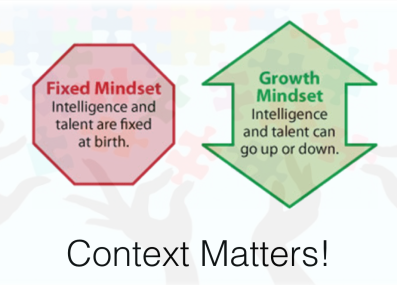
I think there’s an assumption (misconception?) out there that a person is either one mindset or the other. We are usually some combination of both and it often depends on the context. A teacher or student could have a fixed mindset about their math ability but a growth mindset about learning foreign language. What we need to focus on is monitoring our own mindsets in different contexts and developing growth mindsets for students and teachers in all areas of learning.
[Aside: As another example, I confessed in the PD that I battle a very fixed mindset about learning to play the guitar. I was born with clumsy fingers and a lack of physical rhythm and it’s easy to use that as the excuse instead of focusing on deliberately (and joyfully) improving my practice through commitment and focus. Sigh.]
We delved into pages 4-9 in MM. To support their learning and their thinking, I used the following strategy with the coaches.
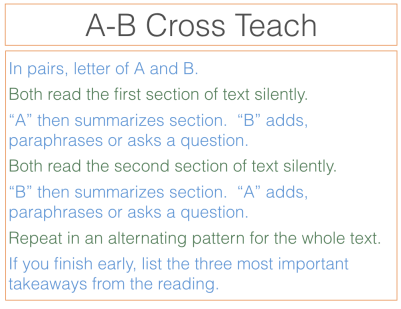
For those of you who just ordered the book online and don’t have your copy yet, here’s my choice for one of most important messages from the reading:

The coaches spent a solid 60 minutes on the reading and really chewing through the material. I had some hesitations dedicating this much time when planning the PD, but in hindsight, it was time well spent. I think it’s essential to support the learning of adults using similar instructional practices that support the learning for their students. This means framing the content well and creating time and space for learners to explore their thinking with each other. Good learning takes time and discourse. If we want our teachers to embody this ethos, then we need to provide PD that embodies it too.
To help them organize and integrate their new learning, I invited them to go through this playful opportunity.
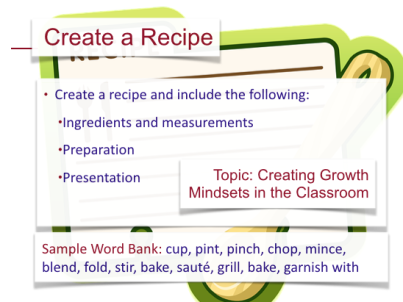
Here’s what they created and presented to the whole group:
After a break, we explored two wonderful instructional strategies Which One Doesn’t Belong and Notice/Wonder. These resources connected nicely to our work from earlier in the morning because they are both low-floor/high-ceiling and low-risk/high-reward learning opportunities for all students to experience meaningful brain growth. Check ’em out.
The bulk of our afternoon work was framed around Andrew Stadel’s invitation during his NCTM Ignite! talk to rethink how we make the most of our instructional time. In case you missed it, a super brief recap of his presentation and my takeaways:
- Here’s an image of how NPR divided up an hour of programming:
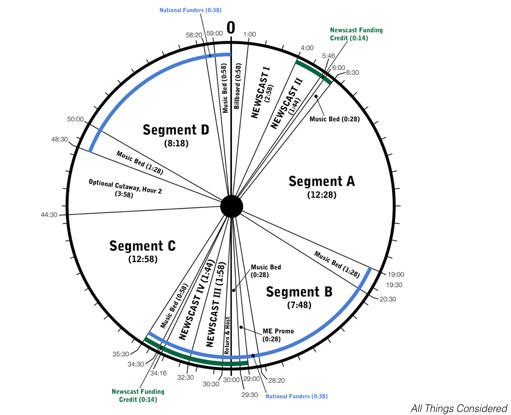
- Key takeaways: It’s tight, efficient, and leads to great radio.
- Here’s how Andrew’s evolved his thinking about how best to use instructional time:
-
Key Takeaways: Like radio, classroom time needs to be tight, efficient, and lead to great learning. Closure is essential; students must have time to reflect on learning and teachers need to capture data. Instructing to the bell isn’t a productive habit. If the primary purpose of math class is to do math and learn how to question and reason mathematically, then the primary focus of classtime should be carved out to let students do that. A very effective way to do that is to offer an interesting and compelling task that is accessible to all learners and using student work to inform and guide instruction. Whenever possible, evidence of student thinking should be used to structure discourse.
Before revealing Andrew’s thinking to the academic couaches, I shared the NPR slide with teachers and then gave them this prompt:
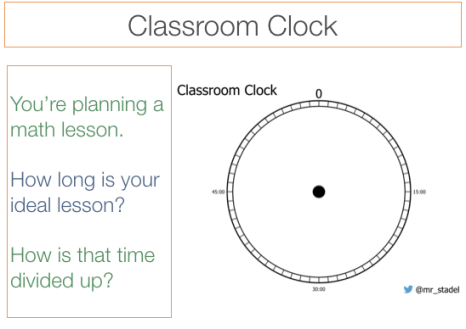
And here’s a snapshot that three of them came up with:
I then shared Andrew’s slides about his own clock(s) and we had an organic and inspiring conversation about the interesting differences and overlap between their thinking and Andrew’s. Almost all the clocks talk about a warm-up, an application problem, some time for conceptual development, and some time for closure.
The coaches also incorporated some language around “fluency practice” and “concept development” into their lessons. Their district has adopted Eureka for their curriculum and this language is used in their own lesson clocks. Here is Eureka’s snapshot of classroom clocks for a whole module:

Five things that I noticed and wondered about classroom clocks:
- Yikes! Elementary students do math for a long time! I had put two clocks on the page because I’d thought we’d do a “thinking before/thinking after” activity with the second clock. But they obviously needed the second clock because their classes go more than 60 minutes and some as long as 120 minutes! Five days a week! That’s a lot of time for rich exploration.
- So, why are middle and high school math classes closer to 45 minutes? Seriously? Anyone know? And why are we surprised when we don’t see enough thoughtful exploration/investigation/discourse in the secondary classroom?
- There’s a lot of ways to interpret and execute “concept development.” It might be an appropriate label for the blue sections in Andrew’s last two clock images. I think it’s a term that needs to be unpacked because it contains a certain blend and sequence of student discourse, problem solving/investigation, direct instruction as Andrew suggests. What’s the best blend? What’s the best sequence? What resources/structures should we be using in PD’s with teachers to help them figure this out?
- I’m doing a lesson inquiry with some 2nd grade teachers next week using Eureka. I’m eager to see more about the choices the authors make around “concept development” on a more granular level. I’ll keep you posted. But I’d be interested to hear from any Eureka users out there that may have something to contribute to the dialogue.
- I might like Eureka’s “Student Debrief” more than the standard “Closure.” I may steal it.
So, my professional takeaway questions moving forward:
- How best to incorporate the brain research and instructional strategies described in MM into productive PD for teachers?
- How best to navigate the “concept development” chunk of our classroom clocks? What ingredients (and in what order) make the best recipe for fostering growth mindsets?
If they are questions that resonate with you, let me know!
Stay groovy, math nerds.
Sorry it took me so long to comment on your post. I’ve had a good mixture of busy and enjoying life. I believe that’s possible, right?
I love how you used this with coaches. Hopefully it infiltrates the reflection process of those teachers that the coaches support. I absolutely love this thought of yours, “evidence of student thinking should be used to structure discourse.”
I especially love how this implies that we need to give students the time to think, time to organize their thinking, and time to articulate their thinking. I constantly think how much time we can gift students to think and communicate if we teachers just shut up more. The extension of the clock for me would be to now encourage teachers to time how much they talk and compare it to the time given to think and the time given to students to discuss math. Hmmmm… sounds like a wonderful ratios tasks for teachers. I digress.
Your noticing and wondering about classroom clocks at the end is spot on. I had to cut the disproportionate time in secondary math classes out of my Ignite talk. I find it challenging to raise that topic without either primary or secondary whining, one way or the other.
I’m interested to know more about concept development and hopefully future blog posts from you on that. Keep up the blogging!
LikeLike
Thanks for the thoughtful words, Andrew. Always good to read your stuff.
I think the classroom clock tool can be a good (safe?) coaching tool to frame conversations and data about: what am i really doing in my class? am i aligning my choices about time with my beliefs about learning? As for infiltrating the reflection process…. I hope so. I’ve got a lot of swirling thoughts about how to inspire learning/growth for professionals. (More thoughts coming in the next post.)
Speaking of ratios, have you seen this: https://www.youtube.com/watch?v=1IbKHSNOOD8 It’s about ratios of talking on a bad date. Leads to the question, what’s a “best” ratio for teacher : student talk? And what factors inform our decision?
LikeLike